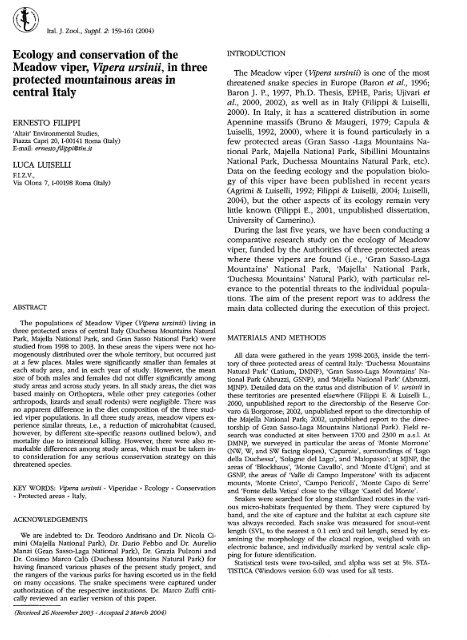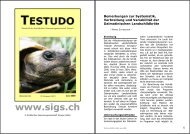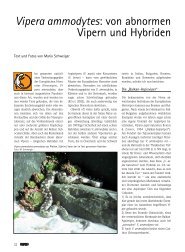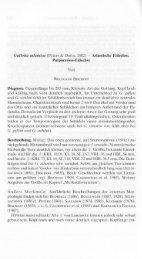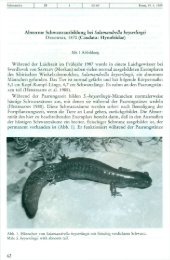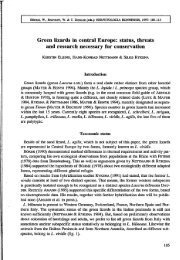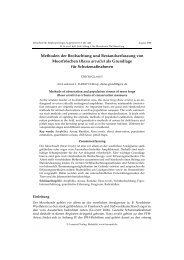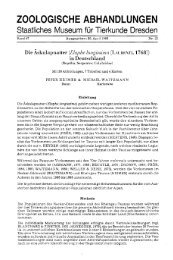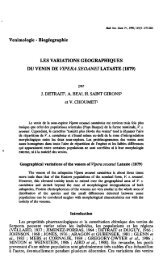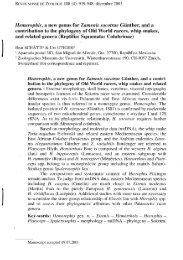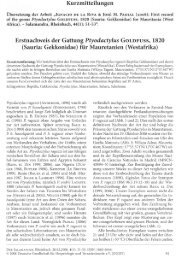Ecology and conservation of the Meadow viper ... - VipersGarden
Ecology and conservation of the Meadow viper ... - VipersGarden
Ecology and conservation of the Meadow viper ... - VipersGarden
You also want an ePaper? Increase the reach of your titles
YUMPU automatically turns print PDFs into web optimized ePapers that Google loves.
Downloaded by [91.113.179.246] at 05:44 16 December 2011<br />
Ital. J. Zool., Suppl. 2: 159-161 (2004)<br />
<strong>Ecology</strong> <strong>and</strong> <strong>conservation</strong> <strong>of</strong> <strong>the</strong><br />
<strong>Meadow</strong> <strong>viper</strong>, Vipera ursinii, in three<br />
protected mountainous areas in<br />
central Italy<br />
ERNESTO FILIPPI<br />
'Altair' Environmental Studies,<br />
Piazza Capri 20, I-00141 Roma (Italy)<br />
E-mail: ernesto.filippi@tin.it<br />
LUCA LUISELLI<br />
F.I.Z.V.,<br />
Via Olona 7, I-00198 Roma (Italy)<br />
ABSTRACT<br />
The populations <strong>of</strong> <strong>Meadow</strong> Viper (Vipera ursinii) living in<br />
three protected areas <strong>of</strong> central Italy (Duchessa Mountains Natural<br />
Park, Majella National Park, <strong>and</strong> Gran Sasso National Park) were<br />
studied from 1998 to 2003. In <strong>the</strong>se areas <strong>the</strong> <strong>viper</strong>s were not homogenously<br />
distributed over <strong>the</strong> whole territory, but occurred just<br />
at a few places. Males were significantly smaller than females at<br />
each study area, <strong>and</strong> in each year <strong>of</strong> study. However, <strong>the</strong> mean<br />
size <strong>of</strong> both males <strong>and</strong> females did not differ significantly among<br />
study areas <strong>and</strong> across study years. In all study areas, <strong>the</strong> diet was<br />
based mainly on Orthoptera, while o<strong>the</strong>r prey categories (o<strong>the</strong>r<br />
arthropods, lizards <strong>and</strong> small rodents) were negligible. There was<br />
no apparent difference in <strong>the</strong> diet composition <strong>of</strong> <strong>the</strong> three studied<br />
<strong>viper</strong> populations. In all three study areas, meadow <strong>viper</strong>s experience<br />
similar threats, i.e., a reduction <strong>of</strong> microhabitat (caused,<br />
however, by different site-specific reasons outlined below), <strong>and</strong><br />
mortality due to intentional killing. However, <strong>the</strong>re were also remarkable<br />
differences among study areas, which must be taken into<br />
consideration for any serious <strong>conservation</strong> strategy on this<br />
threatened species.<br />
KEY WORDS: Vipera ursinii - Viperidae - <strong>Ecology</strong> - Conservation<br />
- Protected areas - Italy.<br />
ACKNOWLEDGEMENTS<br />
We are indebted to: Dr. Teodoro Andrisano <strong>and</strong> Dr. Nicola Cimini<br />
(Majella National Park), Dr. Dario Febbo <strong>and</strong> Dr. Aurelio<br />
Manzi (Gran Sasso-Laga National Park), Dr. Grazia Pulzoni <strong>and</strong><br />
Dr. Cosimo Marco Calo (Duchessa Mountains Natural Park) for<br />
having financed various phases <strong>of</strong> <strong>the</strong> present study project, <strong>and</strong><br />
<strong>the</strong> rangers <strong>of</strong> <strong>the</strong> various parks for having escorted us in <strong>the</strong> field<br />
on many occasions. The snake specimens were captured under<br />
authorization <strong>of</strong> <strong>the</strong> respective institutions. Dr. Marco Zuffi critically<br />
reviewed an earlier version <strong>of</strong> this paper.<br />
(Received 26November 2003 - Accepted 2 March 2004)<br />
INTRODUCTION<br />
The <strong>Meadow</strong> <strong>viper</strong> {Vipera ursinii) is one <strong>of</strong> <strong>the</strong> most<br />
threatened snake species in Europe (Baron et al., 1996;<br />
Baron J. P., 1997, Ph.D. Thesis, EPHE, Paris; Ujivari et<br />
al., 2000, 2002), as well as in Italy (Filippi & Luiselli,<br />
2000). In Italy, it has a scattered distribution in some<br />
Apennine massifs (Bruno & Maugeri, 1979; Capula &<br />
Luiselli, 1992, 2000), where it is found particularly in a<br />
few protected areas (Gran Sasso -Laga Mountains National<br />
Park, Majella National Park, Sibillini Mountains<br />
National Park, Duchessa Mountains Natural Park, etc).<br />
Data on <strong>the</strong> feeding ecology <strong>and</strong> <strong>the</strong> population biology<br />
<strong>of</strong> this <strong>viper</strong> have been published in recent years<br />
(Agrimi & Luiselli, 1992; Filippi & Luiselli, 2004; Luiselli,<br />
2004), but <strong>the</strong> o<strong>the</strong>r aspects <strong>of</strong> its ecology remain very<br />
little known (Filippi E., 2001, unpublished dissertation,<br />
University <strong>of</strong> Camerino).<br />
During <strong>the</strong> last five years, we have been conducting a<br />
comparative research study on <strong>the</strong> ecology <strong>of</strong> <strong>Meadow</strong><br />
<strong>viper</strong>, funded by <strong>the</strong> Authorities <strong>of</strong> three protected areas<br />
where <strong>the</strong>se <strong>viper</strong>s are found (i.e., 'Gran Sasso-Laga<br />
Mountains' National Park, 'Majella' National Park,<br />
'Duchessa Mountains' Natural Park), with particular relevance<br />
to <strong>the</strong> potential threats to <strong>the</strong> individual populations.<br />
The aim <strong>of</strong> <strong>the</strong> present report was to address <strong>the</strong><br />
main data collected during <strong>the</strong> execution <strong>of</strong> this project.<br />
MATERIALS AND METHODS<br />
All data were ga<strong>the</strong>red in <strong>the</strong> years 1998-2003, inside <strong>the</strong> territory<br />
<strong>of</strong> three protected areas <strong>of</strong> central Italy: 'Duchessa Mountains<br />
Natural Park' (Latium, DMNP), 'Gran Sasso-Laga Mountains' National<br />
Park (Abruzzi, GSNP), <strong>and</strong> 'Majella National Park' (Abruzzi,<br />
MJNP). Detailed data on <strong>the</strong> status <strong>and</strong> distribution <strong>of</strong> V. ursinii in<br />
<strong>the</strong>se territories are presented elsewhere (Filippi E. & Luiselli L.,<br />
2000, unpublished report to <strong>the</strong> directorship <strong>of</strong> <strong>the</strong> Reserve Corvaro<br />
di Borgorose; 2002, unpublished report to <strong>the</strong> directorship <strong>of</strong><br />
<strong>the</strong> Majella National Park; 2002, unpublished report to <strong>the</strong> directorship<br />
<strong>of</strong> Gran Sasso-Laga Mountains National Park). Field research<br />
was conducted at sites between 1700 <strong>and</strong> 2300 m a.s.l. At<br />
DMNP, we surveyed in particular <strong>the</strong> areas <strong>of</strong> 'Monte Morrone'<br />
(NW, W, <strong>and</strong> SW facing slopes), 'Caparnie', surroundings <strong>of</strong> 'Lago<br />
della Duchessa', 'Solagne del Lago', <strong>and</strong> 'Malopasso'; at MJNP, <strong>the</strong><br />
areas <strong>of</strong> 'Blockhaus', 'Monte Cavallo', <strong>and</strong> 'Monte d'Ugni'; <strong>and</strong> at<br />
GSNP, <strong>the</strong> areas <strong>of</strong> 'Valle di Campo Imperatore' with its adjacent<br />
mounts, 'Monte Cristo', 'Campo Pericoli', 'Monte Capo di Serre'<br />
<strong>and</strong> 'Fonte della Vetica' close to <strong>the</strong> village 'Castel del Monte'.<br />
Snakes were searched for along st<strong>and</strong>ardized routes in <strong>the</strong> various<br />
micro-habitats frequented by <strong>the</strong>m. They were captured by<br />
h<strong>and</strong>, <strong>and</strong> <strong>the</strong> site <strong>of</strong> capture <strong>and</strong> <strong>the</strong> habitat at each capture site<br />
was always recorded. Each snake was measured for snout-vent<br />
length (SVL, to <strong>the</strong> nearest ±0.1 cm) <strong>and</strong> tail length, sexed by examining<br />
<strong>the</strong> morphology <strong>of</strong> <strong>the</strong> cloacal region, weighed with an<br />
electronic balance, <strong>and</strong> individually marked by ventral scale clipping<br />
for future identification.<br />
Statistical tests were two-tailed, <strong>and</strong> alpha was set at 5%. STA-<br />
TISTICA (Windows version 6.0) was used for all tests.
Downloaded by [91.113.179.246] at 05:44 16 December 2011<br />
160 E. FILIPPI, L. LUISELLI<br />
RESULTS AND DISCUSSION<br />
A total <strong>of</strong> 110 males <strong>and</strong> 114 females were marked<br />
<strong>and</strong> measured for SVL. Statistics <strong>of</strong> <strong>the</strong> mean SVL <strong>of</strong><br />
<strong>Meadow</strong> <strong>viper</strong>s at <strong>the</strong> three protected study areas, divided<br />
by sex <strong>and</strong> year <strong>of</strong> study, are presented in Table<br />
I. Males were significantly smaller than females at each<br />
study area, <strong>and</strong> in each year <strong>of</strong> study. However, <strong>the</strong><br />
mean size <strong>of</strong> both males <strong>and</strong> females did not differ significantly<br />
among study areas <strong>and</strong> across study years (at<br />
least P > 0.4 with ANOVA analysis). These results are<br />
fully consistent with those presented in studies <strong>of</strong> conspecifics<br />
from elsewhere (Baron et al., 1996; Baron J. P.,<br />
1997, Ph.D. Thesis, EPHE, Paris).<br />
Food items were found in faeces <strong>of</strong> 175 different<br />
specimens <strong>of</strong> <strong>Meadow</strong> <strong>viper</strong>s, <strong>and</strong> <strong>the</strong>ir dietary data collected<br />
at <strong>the</strong> three study areas are presented in Table II.<br />
The diet was based mainly on Orthoptera, while o<strong>the</strong>r<br />
prey categories (o<strong>the</strong>r arthropods, lizards, <strong>and</strong> small rodents)<br />
were negligible. There was no apparent difference<br />
in <strong>the</strong> diet composition <strong>of</strong> <strong>the</strong> three studied <strong>viper</strong><br />
populations (Table II), <strong>and</strong> our original data fully agree<br />
with those presented by Agrimi & Luiselli (1992), relative<br />
to <strong>the</strong> <strong>viper</strong> population inhabiting <strong>the</strong> 'Valle di<br />
Campo Imperatore' in <strong>the</strong> GSNP.<br />
The main direct <strong>and</strong> indirect threats to <strong>the</strong> continued<br />
existence <strong>of</strong> <strong>Meadow</strong> <strong>viper</strong>s in <strong>the</strong> three study areas are<br />
summarized in Fig. 1. From <strong>the</strong> comparison <strong>of</strong> <strong>the</strong> figures<br />
it emerges that, in all three study areas, <strong>Meadow</strong><br />
<strong>viper</strong>s experience similar threats, notably a reduction <strong>of</strong><br />
microhabitat (caused, however, by different site-specific<br />
reasons outlined below), <strong>and</strong> mortality due to intentional<br />
killing. However, <strong>the</strong>re were also remarkable differences<br />
among study areas which must be outlined in order<br />
to implement a reliable <strong>conservation</strong> strategy for<br />
this species. In <strong>the</strong> DMNP, part <strong>of</strong> <strong>the</strong> area inhabited by<br />
TABLE I - Statistics (means ± st<strong>and</strong>ard deviation) <strong>of</strong> <strong>the</strong> body<br />
length (SVL) <strong>of</strong> <strong>Meadow</strong> <strong>viper</strong>s at three protected study areas, divided<br />
by sex <strong>and</strong> year <strong>of</strong> study. Statistical significance is always<br />
assessed by Student-t test. Symbols: DMNP, Duchessa Mountains'<br />
Natural Park; GSNP, Gran Sasso-Laga Mountains' National Park;<br />
MJNP, Majella National Park. In brackets <strong>the</strong> number <strong>of</strong> examined<br />
<strong>viper</strong>s.<br />
Areas <strong>and</strong> year<br />
<strong>of</strong> study<br />
DMNP<br />
2000<br />
2002<br />
MJNP<br />
2000<br />
2001<br />
GSNP<br />
2002<br />
Males Females<br />
29.9 ± 0.04 (7) 35.1 ± 3.5 (8) < 0.001<br />
27.8 + 2.03 (8) 33.7 ± 2.6 (5) 0.0008<br />
30.4 ± 1.03 (8) 37.6 ± 3.5 (10) < 0.001<br />
30.7 ±1.11 (23) 39.1 ± 2.9 (28) < 0.0001<br />
31.3 ± 2.14 (64) 39.8 ± 4.9 (63) < 0.0001<br />
INTENTIONAL<br />
KILLING AND PET-<br />
COLLECTING<br />
INTENTIONAL<br />
KILLING AND PET-<br />
COLLECTING<br />
POPULATION OF ITpera uninll<br />
POPULATION OF ITpera aninU<br />
OVERGRAZING<br />
POPULATION OF Viptra ursinii<br />
Fig. 1 - Diagram showing <strong>the</strong> main direct <strong>and</strong> indirect threats to<br />
<strong>the</strong> <strong>conservation</strong> <strong>of</strong> <strong>the</strong> populations <strong>of</strong> Vipera ursinii at <strong>the</strong> three<br />
study areas. A, Duchessa Mountains' Natural Park (DMNP); B, Majella<br />
National Park (MJNP); C, Gran Sasso-Laga Mountains' National<br />
Park (GSNP). A was already presented in Filippi & Luiselli<br />
(2004).<br />
V. ursinii was regularly visited by Wild boar (Sus scr<strong>of</strong>a).<br />
Although we did not study <strong>the</strong> effects <strong>of</strong> <strong>the</strong>se large<br />
ungulates on <strong>the</strong> <strong>viper</strong>s, at lower altitude in <strong>the</strong> same<br />
mountain massif we demonstrated (Filippi & Luiselli,<br />
2002) that overpopulation <strong>of</strong> "Wild boars negatively affected<br />
<strong>the</strong> local snake populations via both direct effects<br />
<strong>of</strong> micro-habitat disturbance <strong>and</strong> predation, <strong>and</strong> indirectly<br />
via predation <strong>and</strong> disturbance on <strong>the</strong>ir potential<br />
prey species. Thus, it is very likely that overpopulation<br />
<strong>of</strong> <strong>the</strong>se mammals may also negatively affect populations<br />
<strong>of</strong> V. ursinii in <strong>the</strong> Duchessa Mountains (Filippi &<br />
Luiselli, 2004). In MJNP, <strong>the</strong> main risk for <strong>the</strong> <strong>viper</strong>s is<br />
that <strong>the</strong>ir natural habitat (mountain grassl<strong>and</strong>s) are currently<br />
disappearing due to overforestation <strong>of</strong> Pinus mugo,<br />
which is reducing <strong>the</strong> viable basking habitat for <strong>the</strong><br />
meadow <strong>viper</strong>. A similar phenomenon was also ob-
Downloaded by [91.113.179.246] at 05:44 16 December 2011<br />
ECOLOGY AND CONSERVATION OF VIPERA URSINII IN CENTRAL ITALY 161<br />
TABLE II - Summary <strong>of</strong> <strong>the</strong> dietary data collected (by faeces<br />
analyses) from <strong>Meadow</strong> <strong>viper</strong>s at <strong>the</strong> three study areas. The numbers<br />
indicate <strong>the</strong> sum <strong>of</strong> individual snakes from which a given<br />
prey type was recorded <strong>and</strong> not <strong>the</strong> total number <strong>of</strong> prey items<br />
eaten. The years <strong>of</strong> study are cumulated.<br />
Prey items in faeces DMNP MJNP GSNP<br />
Orthoptera<br />
O<strong>the</strong>r Arthropoda<br />
Podarcis muralis<br />
Rodentia<br />
Total<br />
2<br />
1<br />
1<br />
1<br />
24<br />
40<br />
1<br />
2<br />
3<br />
47<br />
96 2<br />
3<br />
3<br />
104<br />
served in Switzerl<strong>and</strong>, where overforestation seems to<br />
be a main threat for <strong>the</strong> local populations <strong>of</strong> Vipera aspis<br />
0aggi & Baur, 1999). In GSNP, <strong>the</strong> main problem for<br />
<strong>the</strong> <strong>viper</strong>s is <strong>the</strong> presence <strong>of</strong> some large busy roads that<br />
divide very abundant <strong>viper</strong> populations into two subpopulations<br />
(e.g., <strong>the</strong> road running <strong>the</strong> whole length <strong>of</strong><br />
<strong>the</strong> valley <strong>of</strong> 'Campo Imperatore'), <strong>and</strong> also some dirt<br />
roads <strong>and</strong> paths where <strong>the</strong> access <strong>of</strong> cars is not prohibited.<br />
These roads are used by <strong>viper</strong>s both for basking<br />
<strong>and</strong> for displacements (Filippi, 2001), <strong>and</strong> so may represent<br />
a strong source <strong>of</strong> mortality for <strong>the</strong>se threatened<br />
reptiles. It is noteworthy that comparable threats were<br />
observed in Nigeria (Akani e al., 2002), France (Bonnet<br />
et al., 1999) <strong>and</strong>, especially in <strong>the</strong> isl<strong>and</strong> <strong>of</strong> Milos<br />
(Greece), where road mortality is perhaps <strong>the</strong> main<br />
threat for <strong>the</strong> endemic Macro<strong>viper</strong>a schweizeri (Nilson<br />
et al., 1999).<br />
On <strong>the</strong> o<strong>the</strong>r h<strong>and</strong>, <strong>the</strong> effects <strong>of</strong> tourist trekking<br />
seems to be less harmful for <strong>the</strong> <strong>viper</strong>s, at least in two<br />
<strong>of</strong> <strong>the</strong> areas studied. None<strong>the</strong>less, this must be monitored<br />
especially in GSNP, where <strong>the</strong> pressure <strong>of</strong> tourism<br />
is hardly sustainable, at least in a few <strong>viper</strong> sites (i.e.,<br />
Campo Imperatore, Campo Pericoli).<br />
REFERENCES<br />
Akani G. C., Eyo E., Odegbune E., Eniang E. A., Luiselli L., 2002 -<br />
Ecological patterns <strong>of</strong> anthropogeni c mortality <strong>of</strong> suburban<br />
snakes in an African tropical region. Isr. J. Zool., 48: 1-11.<br />
Agrimi U., Luiselli L., 1992 - Feeding strategies <strong>of</strong> <strong>the</strong> <strong>viper</strong> Vipera<br />
ursinii ursinii (Reptilia, Viperidae) in <strong>the</strong> Apennines. Herpetol.<br />
J., 2: 37-42.<br />
Baron J. P., Ferriere R., Clobeit J., Saint Girons H., 1996 - Strategic<br />
démographiqu e de Vipera ursinii ursinii au Mont Ventoux<br />
(France). C. R. Acad. Sci. Paris III, 319: 57-69.<br />
Baron J. P., Ferriere R., Saint Girons H., 1993 - Differentiatio n<br />
morphologique de quatre populations francaises de Vipera ursinii<br />
ursinii Bonaparte, 1835 (Reptilia, Viperidae). Rev. Suisse<br />
Zool., 100: 187-196.<br />
Bonnet X., Naulleau G., Shine R., 1999 - The dangers <strong>of</strong> leaving home:<br />
dispersal <strong>and</strong> mortality in snakes. Biol. Conserv., 89: 39-50.<br />
Bruno S., Maugeri S., 1979 - Rettili d'Italia. Giunti-Martello, Firenze.<br />
Capula M., Luiselli L., 1992 - Distribution <strong>and</strong> <strong>conservation</strong> <strong>of</strong><br />
Vipera ursinii (Reptilia: Viperidae) in Italy. In: Z. Korsos & I. Kiss<br />
(eds), Proc. VI Ord. Gen. Meet. S.E.H., Budapest, pp. 101-105.<br />
Capula M., Luiselli L., 2000 - Vipera ursinii (Bonaparte, 1835). In:<br />
M. A. Bologna, M. Capula & G. M. Carpaneto (eds), Anfibi e<br />
rettili del Lazio, Fratelli Palombi, Roma, pp. 106-107.<br />
Filippi E., Luiselli L., 2000 - Status <strong>of</strong> <strong>the</strong> Italian snake fauna <strong>and</strong><br />
assessment <strong>of</strong> <strong>conservation</strong> threats. Biol. Conserv., 93: 219-226.<br />
Filippi E., Luiselli L., 2002 - Negative effect <strong>of</strong> <strong>the</strong> wild boar (Sus<br />
scr<strong>of</strong>a) on <strong>the</strong> populations <strong>of</strong> snakes at a protected mountainous<br />
forest in central Italy. Ecol. Mediterr., 28: 93-98.<br />
Filippi E., Luiselli L., 2004 - Aspects <strong>of</strong> ecology <strong>and</strong> <strong>conservation</strong><br />
<strong>of</strong> <strong>the</strong> <strong>Meadow</strong> <strong>viper</strong>, Vipera ursinii, at <strong>the</strong> Duchessa Mountains<br />
Natural Park (Latium, central Italy). Herpetol. Bull., 86: 5-9.<br />
Jäggi C., Baur B., 1999 - Overgrowing forest as a possible cause<br />
for <strong>the</strong> local extinction <strong>of</strong> Vipera aspis in <strong>the</strong> nor<strong>the</strong>rn Swiss Jura<br />
Mountains. Amphibia-Reptilia , 20: 25-34.<br />
Luiselli L., 2004 - <strong>Meadow</strong> <strong>viper</strong>, Vipera ursinii, in Italy: aspects <strong>of</strong><br />
<strong>conservation</strong> ecology. Ital. J. Zool., 71 (suppl. 1): 167-172.<br />
Nilson G., Andren C., Ioannidis Y., Dimaki M., 1999 - <strong>Ecology</strong> <strong>and</strong><br />
<strong>conservation</strong> <strong>of</strong> <strong>the</strong> Milos <strong>viper</strong>, Macro<strong>viper</strong>a schweizeri. Amphibia-Reptilia,<br />
20: 355-375.<br />
Ujivari B., Korsos Z., Pechy T., 2000 - Life history, population characteristics<br />
<strong>and</strong> <strong>conservation</strong> <strong>of</strong> <strong>the</strong> Hungarian meadow <strong>viper</strong><br />
(Vipera ursinii rakosiensis). Amphibia-Reptilia , 21: 267-278.<br />
Ujivari B., Madsen T., Kotenko T., Olsson M., Shine R., Wittzell<br />
H., 2002 - Low genetic diversity threatens imminent extinction<br />
for <strong>the</strong> Hungarian meadow <strong>viper</strong> (Vipera ursinii rakosiensis).<br />
Biol. Conserv., 105: 127-130.


